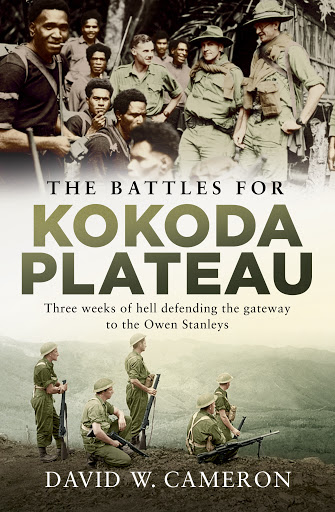After the 8th May Battle of the Coral Sea, the Japanese high command having abandoned the attempt to seize Port Moresby by sea put its effort into a land push south across the Owen Stanley Range, landing a large force at Gona on the north east Papua coast on 21st July.

Paperback 432pp RRP $32.99
The force was met by Captain Sam Templeton’s B Company of the Australian militia’s 39th Battalion, the 1st Papuan Battalion (PIB) and the Royal Papuan Constabulary. Fortunately, Allied airmen made life very difficult for the Japanese as they strove to establish a beachhead and build infrastructure to support the landing of equipment and supplies.
B Company having come from Port Moresby, were exhausted after struggling across the Kokoda Track, and had virtually no heavy weapons and were short in both ammunition and rations.
Realising the strategic importance of the Kokoda airstrip to both sides, an extraordinary effort to prevent its capture by the Japanese ensued in the following three weeks. Captain Templeton was captured on 26th, but continued his stand by grossly exaggerating the numbers garrisoned in Port Moresby, sowing doubts in the minds of his captors before he was summarily executed.
The new Commanding Officer, Lieutenant Colonel Owen, was flown up to Kokoda and on 30th July ordered the burning of the supply dump at Kokoda and a withdrawal to Deniki (several kilometres behind Kokoda). After realising the Japanese had not occupied Kokoda, he led his men back into the village in an attempt to reopen its airfield to receive reinforcements and supplies.
The aircraft dispatched to Kokoda were unable to land due to bad weather. The CO was mortally wounded on the forward slopes of the Kokoda plateau. On 8th August the 39th launched a counterattack at Kokoda but outnumbered and short of ammunition, fell back to Deniki after two days of fighting. The Australians eventually managed to repel the ongoing Japanese attack and on 14th August the 39th and the PIB fell back to Isurava having provided the Allies with vital time to put forces in place to harass the Japanese thrust down the Kokoda Track.
In Melbourne on 10th August 1942 when discussing the fighting around Kokoda, General Thomas Blamey, the Commander of Allied Land Forces in the South West Pacific Area, said that not much was happening there and ‘it was not of great importance’!
As with any war, there are civilian casualties. During these battles, those who had been in the region long before hostilities commenced were in many instances caught behind the Japanese lines, and along with downed airmen were desperate to link up with the Allied forces withdrawing southwards, Some were successful; others were captured, tortured and then executed. Cameron has intertwined their stories, diaries and letters with those of the military members involved. Particularly pertinent are the recollections of 60-year-old Captain ‘Doc’ Vernon whose First World War experience as a physician saw him provide unbelievable support to the sick and wounded during the vital battles in Papua and New Guinea. Service personal mentioned or quoted have all been identified by age, occupation and home town.
In typical Cameron style, the two maps provided are ample for the reader to grasp the detail of the Kokoda theatre. There are high quality photographs and a very detailed Bibliography, and, indicating the depth of his research, in excess of 20 pages of Endnotes. A comprehensive Index is included.
This is a very readable account of the circumstances in which two small and virtually unknown battles took place. Full credit to Cameron for creating this important work that deservedly places one ‘bookend’ on the history of the Kokoda Track.
Reviewed for RUSIV by Neville Taylor, March 2020
Contact Royal United Services Institute about this article.






